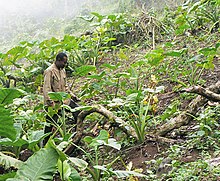Subsistence agriculture

Subsistence agriculture occurs when farmers grow food crops to meet the needs of themselves and their families on smallholdings. Subsistence agriculturalists target farm output for survival and for mostly local requirements, with little or no surplus. Planting decisions occur principally with an eye toward what the family will need during the coming year, and only secondarily toward market prices. Tony Waters writes: "Subsistence peasants are people who grow what they eat, build their own houses, and live without regularly making purchases in the marketplace."
Despite the primacy of self-sufficiency in subsistence farming, todayupdate most subsistence farmers also participate in trade to some degree, though usually for goods that are not necessary for survival, which may include sugar, iron roofing-sheets, bicycles, used clothing, and so forth. Most subsistence farmers today operate in developing countries. Although their amount of trade as measured in cash is less than that of consumers in countries with modern complex markets, many have important trade contacts and trade items that they can produce because of their special skills or special access to resources valued in the marketplace.
Subsistence agriculture generally features: small capital/finance requirements, mixed cropping, limited use of agrochemicals (e.g. pesticides and fertilizer), unimproved varieties of crops and animals, little or no surplus yield for sale, use of crude/traditional tools (e.g. hoes, machetes, and cutlasses), mainly the production of food crops, performed on small scattered plots of land, reliance on unskilled labour (often family members), and (generally) low yields.
Comments
Post a Comment